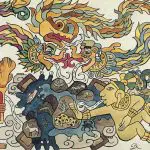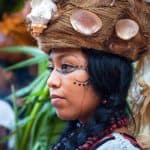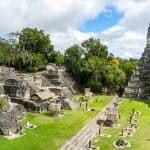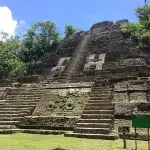You’ve seen stunning images of Mayan temples and palaces, but do you truly know the fascinating story behind them?
Welcome to the world of ancient Mayan architecture, a craft characterized by pyramid-temples and adorned palaces spread across Mesoamerica.
Today we will unlock the artistic complexity and symbolic meanings enshrined in these architectural marvels. Prepare yourself for an expedition back in time into one of mankind’s most remarkable civilizations!
Key Takeaways
- Mayan buildings are famous for pyramid temples and grand palaces. They used local materials like limestone, sandstone, and volcanic tuff.
- All their structures linked to religion. Pyramids were both worship places and resting spots for kings after death.
- Maya cities had creative designs with centers in the heart of the city. They also had special areas such as ballcourts and observatories.
- Homes held spiritual meanings while palaces served as homes for royalty. Temples told rich stories about Maya culture through carvings.
Definition and Influences of Mayan Architecture
Mayan architecture is famous for its pyramid temples and fancy palaces.
These are seen in many Mayan centers across Mesoamerica. The Maya builders were very careful with the layout and place of each building.
They used a common style for all their structures.
The ideas for these buildings came from older cultures near them, like the Olmec and Teotihuacan.
The Olmec people had big stone heads and other carvings that the Maya liked. Later, they also picked up ideas from Teotihuacan’s tall stone pyramids.
The Role of Religion in Mayan Architecture
Gods and beliefs were a big part of Mayan life. They played a key role in how the Mayans built things.
All their buildings had a link to religion, not just temples or holy places. This is because they saw no difference between buildings used for daily tasks and those used for worship.
Many Mayan pyramids were both temples and resting places for kings after death.
The layout of these pyramids lined up with events in the sky like sunsets or star paths. This showed that even when building, the Mayans thought about their gods.
Maya ballcourts also had deep ties to faith. These courts were set up so they matched the positions of stars and other heavenly bodies. Every city was planned with care too, showing how religion fit into every part of life—even town design! The Maya architects made sure that everything looked perfect from stone carvings to location choice.
Mayan people also made use of what nature gave them in their construction work as a show of love for Mother Earth’s gifts.
From sandstone walls to roofs supported by tree trunks, you can see their respect for nature everywhere in Maya architecture.
They added more beauty to these buildings with images and designs linked to their beliefs known as religious iconography—a kind of visual language used each day by all Mayas—they told stories about gods, kings or important days using symbols on walls and monuments.
So you see, it’s clear that faith held more sway than we can ever know over how the ancient Maya designed cities or carved out stunning shapes into raw rock—creating magic where there was once only stone!
Mayan Urban Design and Construction Process
We’ll look deeper into Mayan urban design and their ingenious construction methods that have stood the test of time.
Plus, how they strategically planned cities, used unique materials, and developed advanced techniques for an awe-inspiring architectural legacy.
Urban Design
Mayan architecture shows that they made very careful plans when creating a city.
The people put cultural centers in the heart of every city.
Due to their careful planning, you can see how well the cities work together and look amazing.
Many buildings had stucco on the outside. They also used high relief carvings and three-dimensional sculptures to decorate them.
This gave each building a unique style that told its own story.
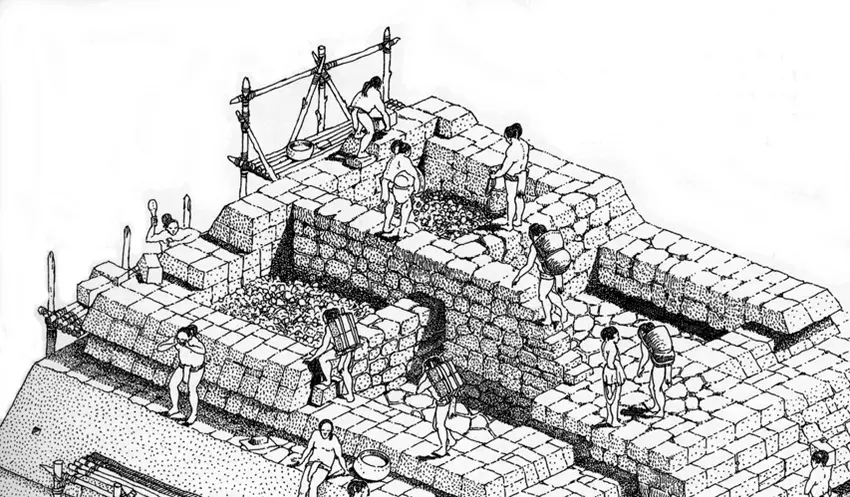
Building Process
Let’s dive into how the Maya built their amazing structures.
- They began with a plan in mind with how everything will connect with everything else.
- They picked materials close by. Limestone, sandstone, and volcanic tuff were top picks.
- Stone tools were used to cut blocks for building.
- Burnt-lime cement acted similar to today’s concrete.
- Interestingly, many Mayan buildings were strategically aligned with solar and celestial events.
- Large open spaces were part of the city layout.
- For big buildings like palaces, they used special roofs known as corbelled roofing.
- Buildings lasted long because of well-engineered construction using cut stones, corbelled vaults and roofs, and hardwood supports.
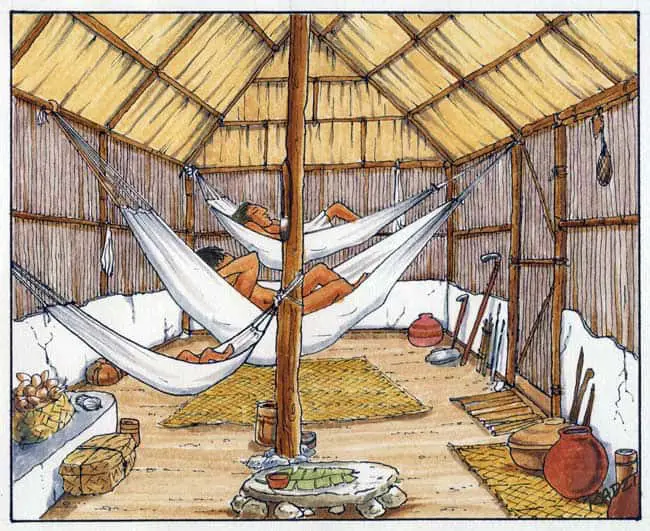
Materials Used in Mayan Architecture
Mayan builders used many different types of materials in their work. Each one had a special part to play.
- Limestone: Most of the buildings were made from this stone. It was easy to find and use.
- Sandstone: This was another common building block. It added color and strength to the structures.
- Volcanic Tuff: This material was strong and could stand up to heavy loads.
- Burnt-lime Cement: Maya workers would burn limestone to make this cement. It worked like concrete.
- Stucco: Mayans used stucco on their buildings’ faces for a smooth finish.
- Wood: Used mainly for supports and ties in roofs.
- Mortar: They mixed it with water to hold stones together.
- Painted Stucco: Mayans painted their buildings for extra beauty and meaning.
Different Types of Mayan Structures
Mayan architecture boasts a variety of intriguing structures, including well-crafted homes that catered to both the elite and commoners.
Grand palaces served as administrative centers and residences for nobility, while imposing temples were focal points for religious practices.
Mayans also developed advanced observatories for studying celestial bodies, along with unique E-group buildings designed in alignment with solar events.
Mayan Homes
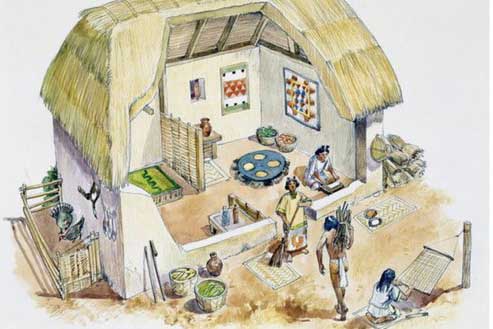
Mayan homes were more than just places to live. They held deep spiritual meanings too.
Made from wood and mud, the walls lined up with the world’s four main points — north, south, east, and west.
Thick grass covered the roofs to keep rain out. Inside each house sat a hearth for cooking food – right at the center!
This spot told a story of creation for all Maya people. It was not just about shelter; it linked daily life to sacred beliefs about how world events took place.
Palaces
Mayan palaces were homes fit for kings and queens. They were big, fancy buildings made of stone like limestone or sandstone.
Each one had special areas inside such as food halls, steam rooms, bathrooms, and tombs.
Even the outside was very grand with carvings and art all around it!
These palaces sat close to pyramids and temples because they held a strong spiritual meaning for the Mayans.
As a tourist, you can see how important these places were in their cities.
Temples
Mayan temples are amazing sights. They look like mountains and show how smart the Mayans were.
The big stone blocks that make up the temples come from nearby quarries. Each block of limestone or sandstone is carved by hand.
The doors to the temples use a post and lintel design, with special vaulting for larger areas.
These great buildings also have “boot rock” which makes bigger spaces possible.
The decorations on these temples tell rich stories about Maya culture and religion through glyphs and carvings.
Observatories
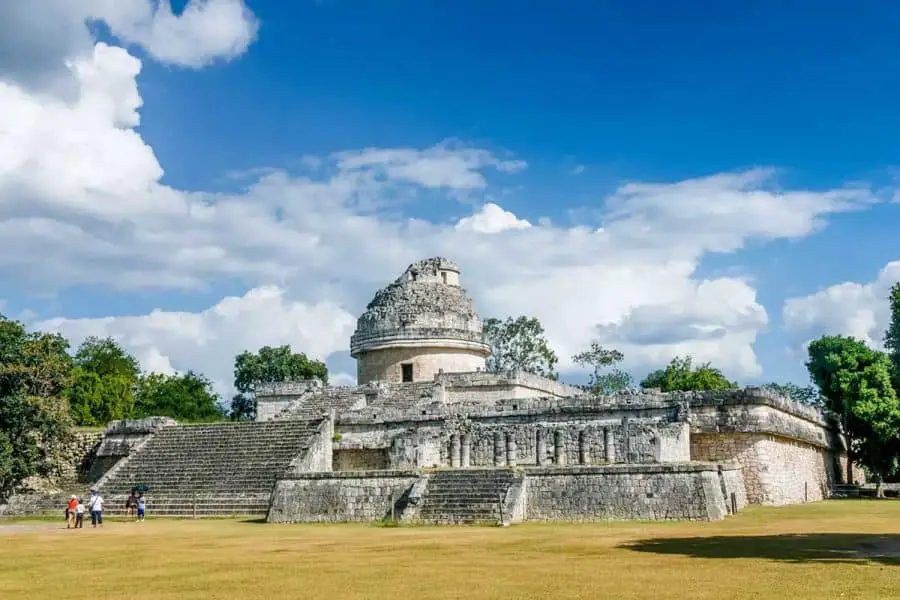
Mayan people had clear views of the sky from observatories. They built these structures to watch stars and other things in the sky.
An observer could stand inside and see the path of a star or even a planet.
These special buildings were part of important Mayan places. Pyramids, temples, and palaces often had observatories near them.
In this way, they could track night skies with ease. This helped them understand seasons, plan crops, and set dates for big events.
E-Group Maya Buildings
E-Group Maya buildings are amazing pieces of work in the Maya world. They stand tall in southern and central Maya lands.
You can spot them by a big stair pyramid on the west side of an open place, known as plaza.
Often, there’s also a raised building on the east side or three smaller temples. More structures sit to the south and north of the plaza too.
The main thing about E-Group buildings is that you can only get to the top by taking an eastern stairway from the plaza.
Some people think these spots were used to watch stars, but digs show this might not be right.
The Marvels of Mayan Architecture
Discover the awe-inspiring marvels of Mayan architecture, from the iconic pyramids and temples that reach toward the heavens to ceremonial platforms and ballcourts that reveal a civilization rich in cultural traditions.
Pyramids and Temples

Mayan pyramids and temples are grand sights to see. They sit on big platforms. Many stairs lead up to the top.
The outsides have carvings that tell tales of gods and kings. These buildings were not just for looking at.
People used them as spots for prayers and rituals. Some even held the tombs of past rulers inside! Each one shows off the great skill of Mayan builders long ago.
Ceremonial Platforms
Mayan ceremonial platforms are full of meaning. These large structures were built with huge stone blocks from nearby quarries. They stand as a sign of the Mayans’ strong belief in spiritual realms.
They used these platforms to carry out their religious acts.
The heart of most Mayan cities had cultural centers, often boasting ceremonial platforms. These spaces were not just for show but served important tasks in their culture and religion.
Both pyramids and palaces got built using methods similar to those used for these platform constructions.
Ballcourts
Ballcourts were big parts of Mayan towns. People used them for playing a game with a large rubber ball that players hit using their hips or knees..
This game was not just fun. It held deep meaning for the Maya people. Ballcourts sat near big places where they had ceremonies, showing their importance in city life.
The game played a part in culture, religion and politics too!
Sometimes, war prisoners had to play the ballgame against champs. If they lost, they faced death!
Significant Maya Pyramids and Temples
The Temple of the Cross Complex and Tikal stand tall as some of the most significant Mayan pyramids and temples, showcasing intricate designs, extensive glyphs, religious iconography, and historical artifacts that offer a fascinating glimpse into ancient Mayan civilization.
Temple of the Cross Complex
The Temple of the Cross Complex is a big part of Mayan history. This place has some of the most famous Maya pyramids and temples.
The buildings are tall and have many levels. They also have roofs that jut out, kind of like an umbrella and huge grand stairs to get you to the top.
You can see how clever they were by looking at where they built their structures – just at the right spots for sun rays or stars to hit them during special times in a year!
Tikal
Tikal is a special place. It was home to big Maya pyramids and temples in its day. On these works, you can see glyphs, shapes, and pictures about religion that are part of the art on the outsides of buildings.
The artists and builders at Tikal used stuff found nearby like limestone, sandstone, and volcanic tuff to make their structures.
The city design had lots of levels with flat tops for buildings. They also built large step-pyramids which look like stairs going up a mountain side!
Roofs were made in a special way called corbelled roofing.
This method makes roofs strong enough to walk on top of them without caving in. Wide stairways led you right up to temple doors.
Mayan Palaces and their Importance
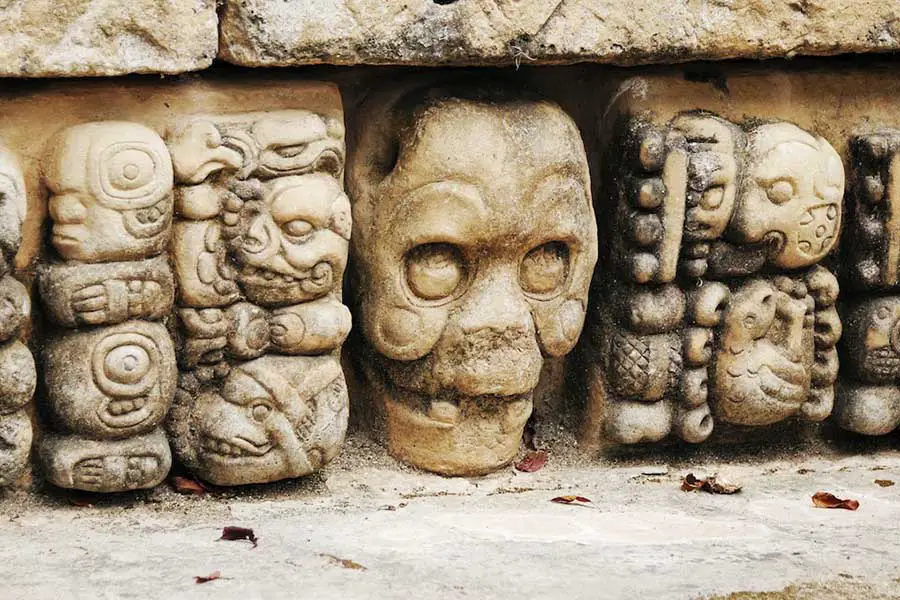
Mayan palaces stood tall as homes for top priests. These places also held tombs, courtyards, food halls, steam rooms and bathrooms. The beliefs of Mayans found a place in these grand buildings.
Every part of the palace was shaped with skill and care by Mayans who knew both art and engineering well.
A palace also showed the power of the ruler. It was more than just a home—it was where big things happened.
People ran the government from here, and moved around following rules based on their religion.
The stones used to build the palaces were cut clean into shape before use.
Today, people still look at these old palaces with awe because they are so well made.
What Are Some Key Features of Mayan Architecture Found in Lamanai Ruins?
When exploring ancient Lamanai ruins, visitors will discover the key features of Mayan architecture, such as intricate stone carvings, elaborate temples, and tall pyramids. The layout of the structures shows an advanced understanding of astronomy and a deep connection to nature, making it a fascinating site to explore.
Surviving Examples of Mayan Architecture
Sayil is a Maya archaeological site in the Mexican state of Yucatán, in the southwest of the state, south of Uxmal.
Sayil is an intriguing surviving example of Mayan architecture, showcasing the use of limestone and intricate carvings in creating ceremonial centers.
Its most notable structure, ‘El Mirador,’ displays a series of tiered platforms and grand stairways that highlight the advanced construction techniques of the ancient Maya civilization.
The site’s Palace, with its three stories and vast number of rooms, provides valuable insights into ancient Mayan residential design.
Also worth noting are other surviving structures like observatories and E-Group buildings which provide evidence for their understanding of astronomy and calendrical cycles.
Each preserved piece serves as a testament to the durability and ingenuity inherent to Mayan architectural design.
Amazing Mayan Structures in Belize
Belize is well known to house several Mayan ruins. Here are just a few of the more popular ruins that you can visit in Belize:
- Actun Tunichil Muknal: This is an old cave rich in Maya history.
- Altun Ha: This was a vital trade center in ancient times.
- Caracol: Once home to over 140,000 people, this site holds clues about Maya life.
- Lamanai: This location boasts stunning temples and wildlife.
- Tikal and Copán: These sites are in Guatemala and Honduras but link back to Xunantunich.
FAQs
1. What is unique about Mayan architecture?
Mayan architecture has many unique features like ornate palaces, elevated platforms with monumental stairways, and pyramid structures built for celestial events.
2. How did the Maya plan their cities?
The Maya used urban planning to design their independent city-states in a radial pattern around focal points for religious practices.
3. What kind of buildings did the Maya build?
The Maya built temples like Temple IV at Tikal, El Tajin in Palenque, and Pyramid of the Magician at Uxmal as centers for religion and tombs for rulers.
4. Did the Mayans play any games?
Yes, Copan ballcourt was built by Mayans for playing the Ballgame of Mesoamerica which was an important part of their culture and religion.
5. Can we still see Mayan Architecture today?
Yes! Many ruins of Mayan structures like those at Copán or Quiriguá are visitable sites where you can learn about its history through engraved glyphs or reliefs they left on it.
6.How were Mayan homes built?
Maya homes often had thatched roofs and were multi-story structures made from materials readily available in their environment.


